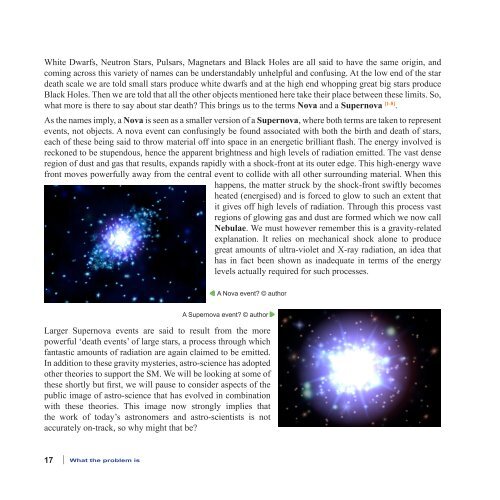A Beginner's View of Our Electric Universe - New
A Beginner's View of Our Electric Universe - New
A Beginner's View of Our Electric Universe - New
Create successful ePaper yourself
Turn your PDF publications into a flip-book with our unique Google optimized e-Paper software.
White Dwarfs, Neutron Stars, Pulsars, Magnetars and Black Holes are all said to have the same origin, and<br />
coming across this variety <strong>of</strong> names can be understandably unhelpful and confusing. At the low end <strong>of</strong> the star<br />
death scale we are told small stars produce white dwarfs and at the high end whopping great big stars produce<br />
Black Holes. Then we are told that all the other objects mentioned here take their place between these limits. So,<br />
what more is there to say about star death? This brings us to the terms Nova and a Supernova [1-8] .<br />
As the names imply, a Nova is seen as a smaller version <strong>of</strong> a Supernova, where both terms are taken to represent<br />
events, not objects. A nova event can confusingly be found associated with both the birth and death <strong>of</strong> stars,<br />
each <strong>of</strong> these being said to throw material <strong>of</strong>f into space in an energetic brilliant flash. The energy involved is<br />
reckoned to be stupendous, hence the apparent brightness and high levels <strong>of</strong> radiation emitted. The vast dense<br />
region <strong>of</strong> dust and gas that results, expands rapidly with a shock-front at its outer edge. This high-energy wave<br />
front moves powerfully away from the central event to collide with all other surrounding material. When this<br />
happens, the matter struck by the shock-front swiftly becomes<br />
heated (energised) and is forced to glow to such an extent that<br />
it gives <strong>of</strong>f high levels <strong>of</strong> radiation. Through this process vast<br />
regions <strong>of</strong> glowing gas and dust are formed which we now call<br />
Nebulae. We must however remember this is a gravity-related<br />
explanation. It relies on mechanical shock alone to produce<br />
great amounts <strong>of</strong> ultra-violet and X-ray radiation, an idea that<br />
has in fact been shown as inadequate in terms <strong>of</strong> the energy<br />
levels actually required for such processes.<br />
Larger Supernova events are said to result from the more<br />
powerful ‘death events’ <strong>of</strong> large stars, a process through which<br />
fantastic amounts <strong>of</strong> radiation are again claimed to be emitted.<br />
In addition to these gravity mysteries, astro-science has adopted<br />
other theories to support the SM. We will be looking at some <strong>of</strong><br />
these shortly but first, we will pause to consider aspects <strong>of</strong> the<br />
public image <strong>of</strong> astro-science that has evolved in combination<br />
with these theories. This image now strongly implies that<br />
the work <strong>of</strong> today’s astronomers and astro-scientists is not<br />
accurately on-track, so why might that be?<br />
17 | What the problem is<br />
A Nova event? © author<br />
A Supernova event? © author


